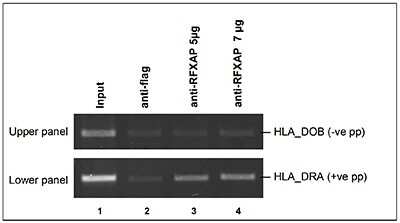RFXAP Antibody
Novus Biologicals, part of Bio-Techne | Catalog # NBP3-18683

Key Product Details
Species Reactivity
Human
Applications
Chromatin Immunoprecipitation (ChIP)
Label
Unconjugated
Antibody Source
Polyclonal Rabbit
Concentration
1 mg/ml
Product Specifications
Immunogen
Polyclonal antibody raised in rabbit against RFXAP (Regulatory factor X-associated protein), using the recombinant protein.
Clonality
Polyclonal
Host
Rabbit
Scientific Data Images for RFXAP Antibody
Chromatin Immunoprecipitation: RFXAP Antibody [NBP3-18683] - Figure 1 ChIP results obtained with the antibody directed against RFXAP ChIP assays were performed using NALM cells (a cell line derived from human pre-B leukemia), the antibody against RFXAP and optimized primer sets for PCR. Sheared chromatin from 2 million cells and respectively 5 and 7 ug of antibody were used per ChIP experiment. An anti-flag antibody (lane 2) was used as negative IP control. Figure 1 shows the result of the end-point PCR with primers for HLA_DRA, used as positive control (lower panel) and for HLA_DOB, used a negative PCR control (upper panel).
Applications for RFXAP Antibody
Application
Recommended Usage
Chromatin Immunoprecipitation (ChIP)
5-7 ug/IP
Application Notes
Please note that of the optimal antibody amount per IP should be determined by the end-user. We recommend testing 1-10 ug per IP.
Formulation, Preparation, and Storage
Purification
Affinity purified
Formulation
PBS
Preservative
0.05% Sodium Azide and 0.05% ProClin 300
Concentration
1 mg/ml
Shipping
The product is shipped with dry ice or equivalent. Upon receipt, store it immediately at the temperature recommended below.
Stability & Storage
Store at -20C short term. Aliquot and store at -80C long term. Avoid freeze-thaw cycles.
Background: RFXAP
Alternate Names
regulatory factor X-associated protein, RFX DNA-binding complex 36 kDa subunit, RFX-associated protein
Gene Symbol
RFXAP
Additional RFXAP Products
Product Specific Notices for RFXAP Antibody
This product is for research use only and is not approved for use in humans or in clinical diagnosis. Primary Antibodies are guaranteed for 1 year from date of receipt.
